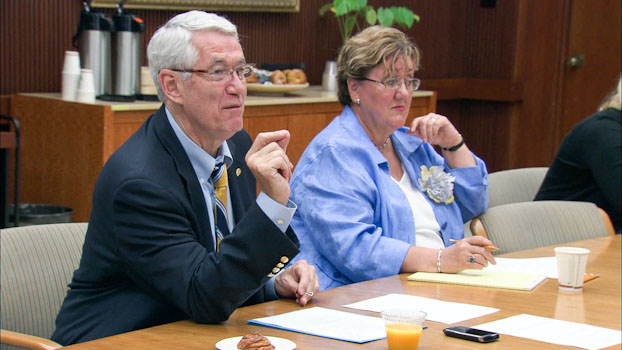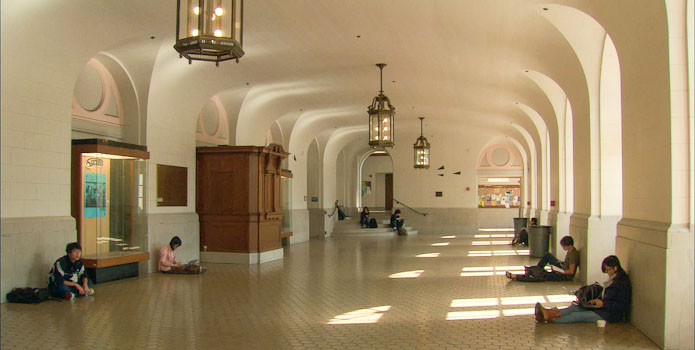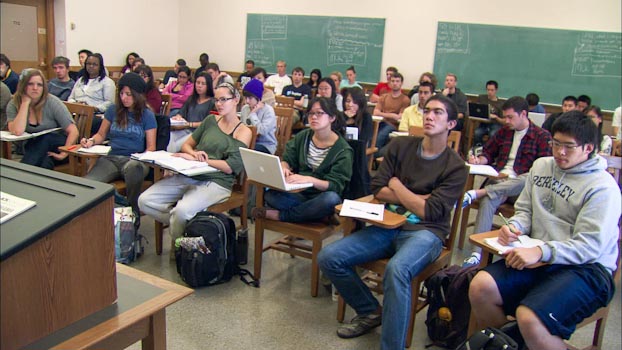At approximately the two-and-one-half-hour mark of Frederick Wiseman’s new four-hour documentary At Berkeley, we drop in on a public policy seminar by Prof. Robert Reich (one of the only immediately recognizable “stars” in the film). He is explaining to students the need for administrators to be self-critical and to have an at least semi-formal process in place by which they may evaluate their progress. “There are ways in which a group becomes positively self-conscious about its process […] and also in terms of what it defines as success.” Seconds later, we see a man on a tractor mowing the lawn, one of the many sloping hills between the buildings on the grounds of the UC Berkeley campus.
Taken by itself, this edit would be meaningless. Throughout At Berkeley, Wiseman uses shots of the campus, sometimes featuring students in transit but often showing physical plant workers—groundskeepers, janitors, construction workers—engaged in the material effort needed to make the University of California, Berkeley, function. (Interestingly enough, Wiseman does not show any clerical staff, apart from the executive assistants to former Chancellor Robert Birgeneau.) However, the lawnmower shot specifically harks back to a discussion earlier in the film. Throughout most of At Berkeley, Wiseman alternates between two types of material: classroom visits (which I will discuss in a moment), and a lengthy strategy meeting in the Chancellor’s office among the heads of the various deans and infrastructural department heads. All are addressing the consequences of budget cuts. During the meeting, one man, presumably from Physical Plant (no one in the film is identified), explains that his department now employs only one lawnmower, who is responsible for maintaining the entire Cal campus.
So, Wiseman follows Reich’s talk about self-criticism and success by showing us “The Lawnmower,” calmly but diligently at work. As his department head notes, the job is important. If people come onto campus and it looks unkempt, they form an immediate impression of the university as a whole. And, the lawnmower’s boss remarks to the chancellor, vice chancellor, and the deans with evident pride, that one guy is “still able to keep this place looking good.” This inclusion, and the fact that Wiseman places the description and its subject approximately one hour apart, speaks to the filmmaker’s own notions of success and self-criticism.
Like many of Wiseman’s documentaries, At Berkeley is long. However, the film uses its extended time to ask us to keep things in mind across the long haul. We see something discussed in the abstract, then observe its material manifestation later. This speaks to Wiseman’s belief that human organization is fundamentally bureaucratic, and that, like it or not, strategic planning is the only way in which large numbers of people can accomplish broad tasks. During the third hour, we see Executive Vice Chancellor George Breslauer speaking to a group of department chairs. He explains the importance of rational argument and evidence over passion and “cheerleading,” and although Wiseman is too sly to come right out and divulge his own viewpoint, the trajectory of At Berkeley demonstrates that Breslauer’s comments could serve as the film’s statement of purpose.
This can be seen in part because of everything Wiseman shows us in the classrooms and laboratories of Berkeley. Wiseman didn’t choose this school by chance. As the U.S.’s preeminent public university, Berkeley serves as a kind of test case for whether excellence in higher education can and should continue to exist as a state-subsidized entity and, by extension, a part of that rapidly deteriorating concept, “the public good.” So we are allowed to “audit” Berkeley at length. We drop in on high-tech human prosthetics research; a discussion of sexuality in the poetry of John Donne; a consideration of the basis for human perception of time; a close reading of Walden, focusing on the meaning of “the natural;” a lecture by breast cancer research pioneer Mina Bissell; a debate about the shifting access to a Berkeley education as part of the larger neoliberal economic turn; and even such non-course assemblies as a financial aid advice session and a meeting of the Cal Veterans group.
This, Wiseman clearly insists, is the business of Berkeley, what it stands for and what it can accomplish at its best. The trouble with At Berkeley, as I see it, is that Wiseman’s editorial rhetoric–which is practically an A/B roll structure—equates these instances of higher learning and research with acts of administration, and with one key meeting by Robert Birgeneau in particular. This becomes crystal clear as student protesters gear up for an action intended to draw attention to what they consider to be unfair tuition hikes and budgetary cuts.
Wiseman depicts the protesters as disruptive loudmouths, a postmodern shadow of the great Free Speech Movement of the 1960s. In fact, after the protest, we even cut to Birgeneau laughing them off as “incoherent,” compared to the Vietnam era protesters of whom he was a part. Note, Birgeneau and Breslauer cooperated with Wiseman in the making of At Berkeley, which in itself does not mean that the final film is a biased infomercial for UCB administration. Nor am I claiming that the student protesters were somehow in the right. I am merely pointing out certain facts about Wiseman’s formal organization of a film that, by his own reckoning, was winnowed down from hundreds of hours of material. We only hear the students’ demands as articulated through the administration. The students, after having occupied Doe Library, peacefully vacated the space at closing time, although we do not see this; we only hear about it from the Chancellor’s harried staff, followed by a cut to the empty Reading Room. Birgeneau gets a last word, with which to establish his own radical bona fides (he was a 60s anti-war protester). And then, we see a professor/administrator in a classroom, allowing “moderate” students to air their frustrations with the protest.
This treatment of the protesters and their “crazy” demands (whatever they are) tells us that Wiseman believes they are naïve. They don’t understand what it takes to run a massive bureaucracy, and when they chant, “Whose university? OUR university!” this is arrogance borne from privilege, rather than a retaking of democracy. By contrast, Wiseman has sympathy for those whose efforts to work within the system fail, through no fault of their own. When a representative of the clerical staff tries to address Chancellor Birgeneau about layoffs, asking that the harsh side of budget cuts be acknowledged—really, that the positive spin be mitigated, out of respect for those deemed “redundant” in tough times”—Birgeneau spouts more chipper rhetoric, about how sacrifices have saved Cal, and prevented the loss of even more jobs. Yes, but this is cold comfort if you’re the one on the chopping block. Still, Wiseman includes this moment, something that can’t be said of much of the protests.
So what can we take from At Berkeley? Like I said, I don’t mean to suggest that Wiseman is or ever was in the pocket of Birgeneau or the UCB regents. Rather, I think his point of view simply aligns with theirs. Wiseman is a classical Weberian liberal. He believes in the bureaucratic preservation of the public sphere, through argumentation and debate, and eventually through legislation and what today’s technocrats call “best practices.” The protesters’ Marxist or Anarchist approach holds no water for him, and even if they were able to articulate it, rationally and with evidence, Wiseman has already decided that the discourses to which they subscribe are invalid. So those arguments will be excluded from the film.
I couldn’t help but think of the frustrations of Obama supporters, who insist that those of us who criticize the president from the left are only “making things worse.” The reforms and belt-tightening that many have supported, in order to help UC Berkeley survive the collapse of the California economy, are clearly not over. Only with time will we discover the ultimate fate of “the public good.”







